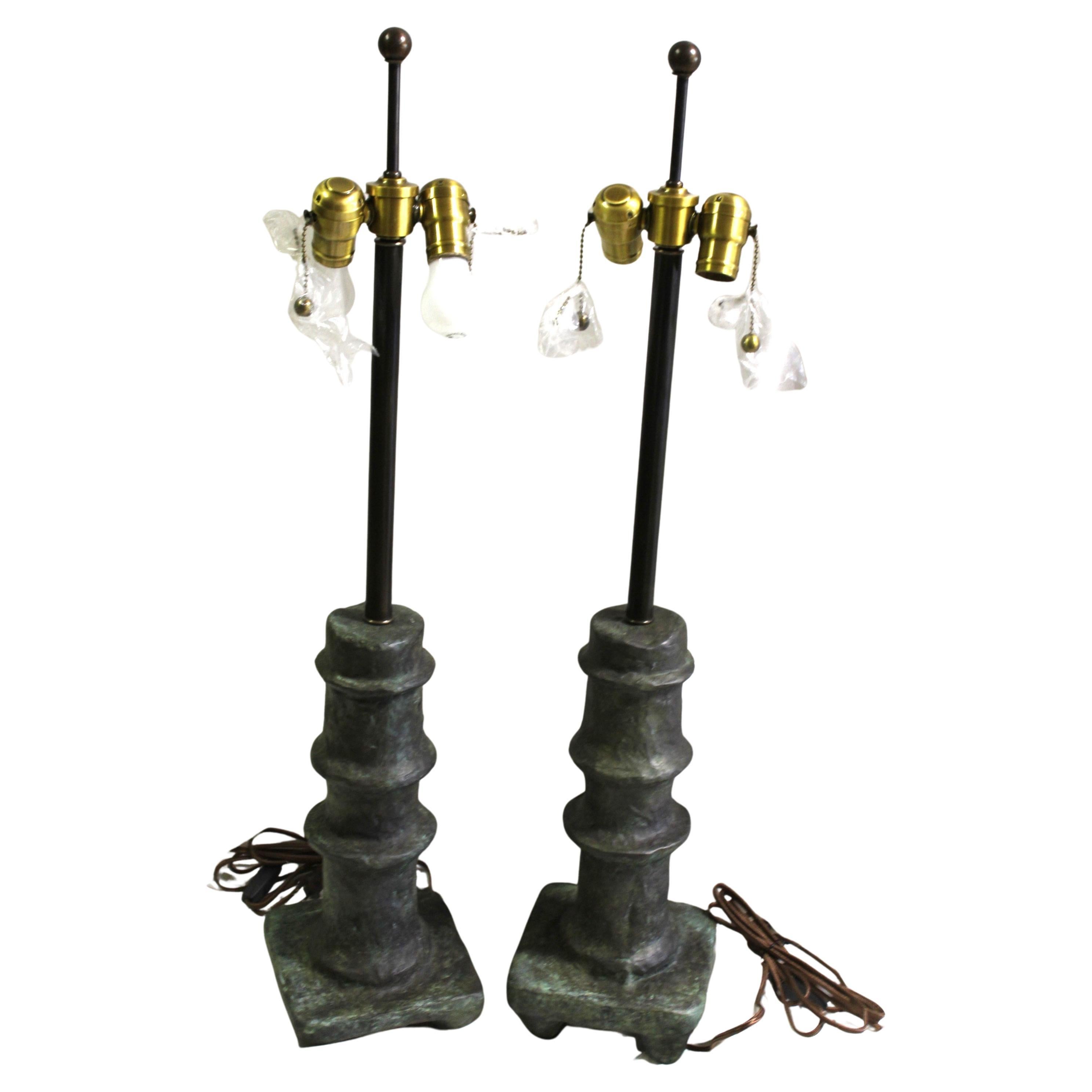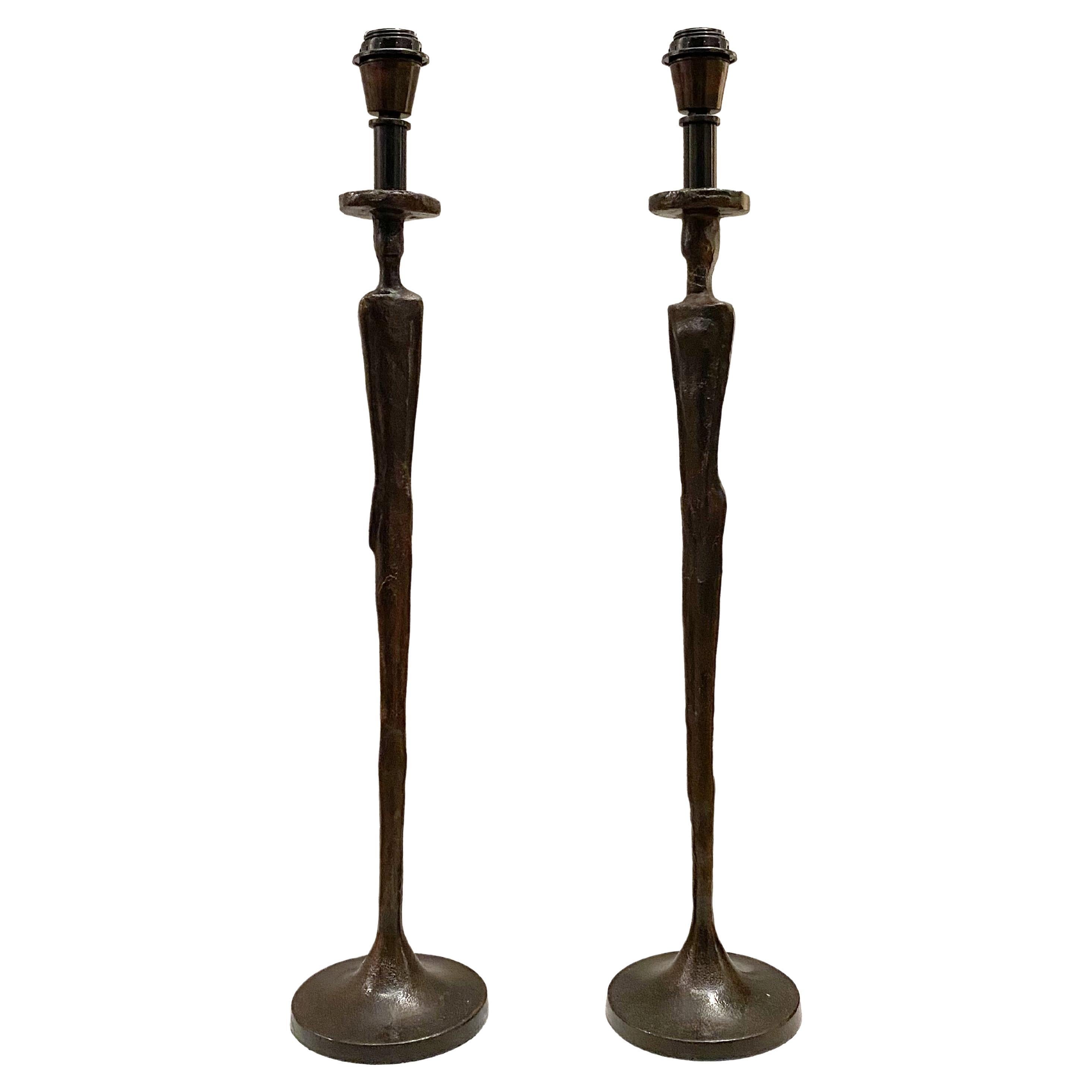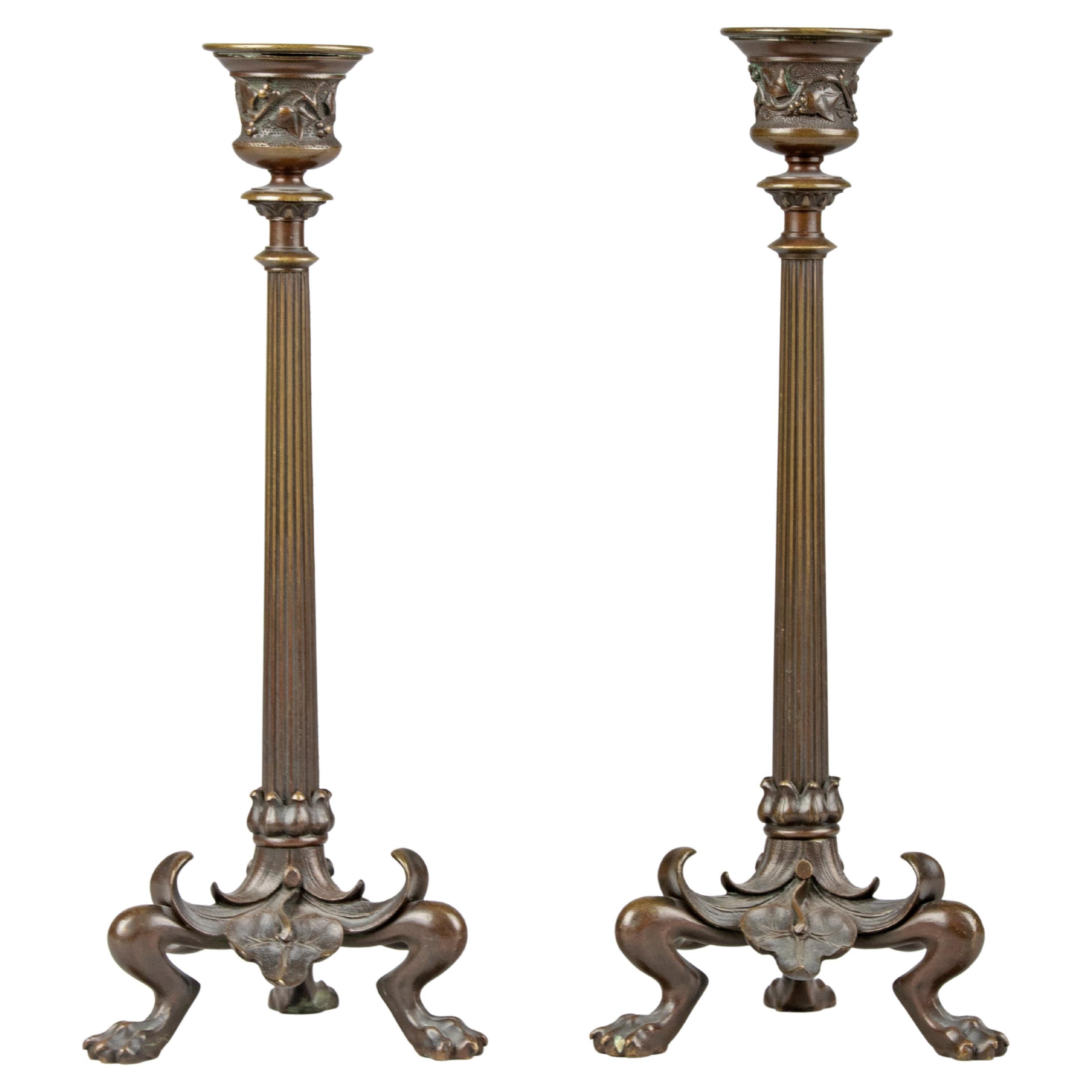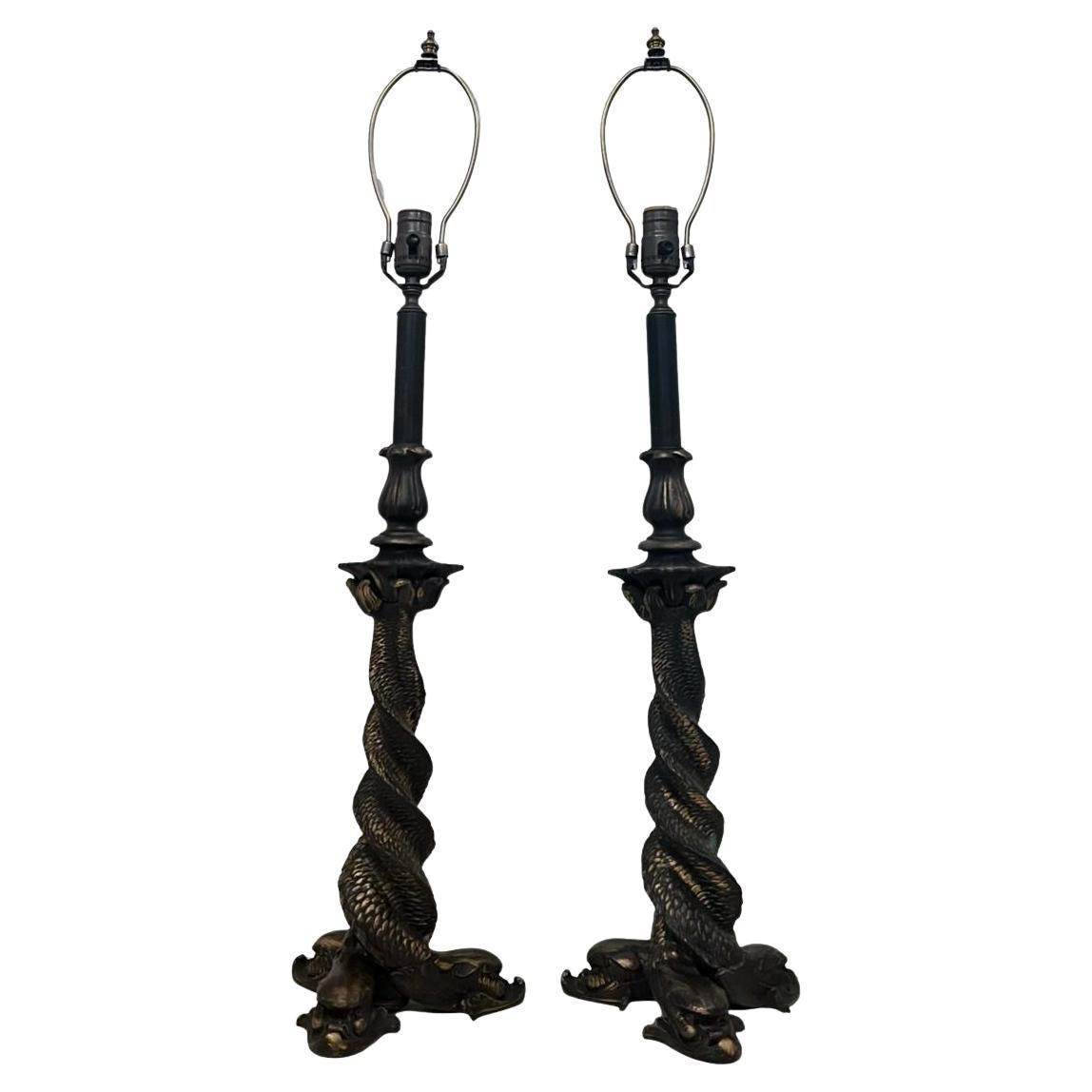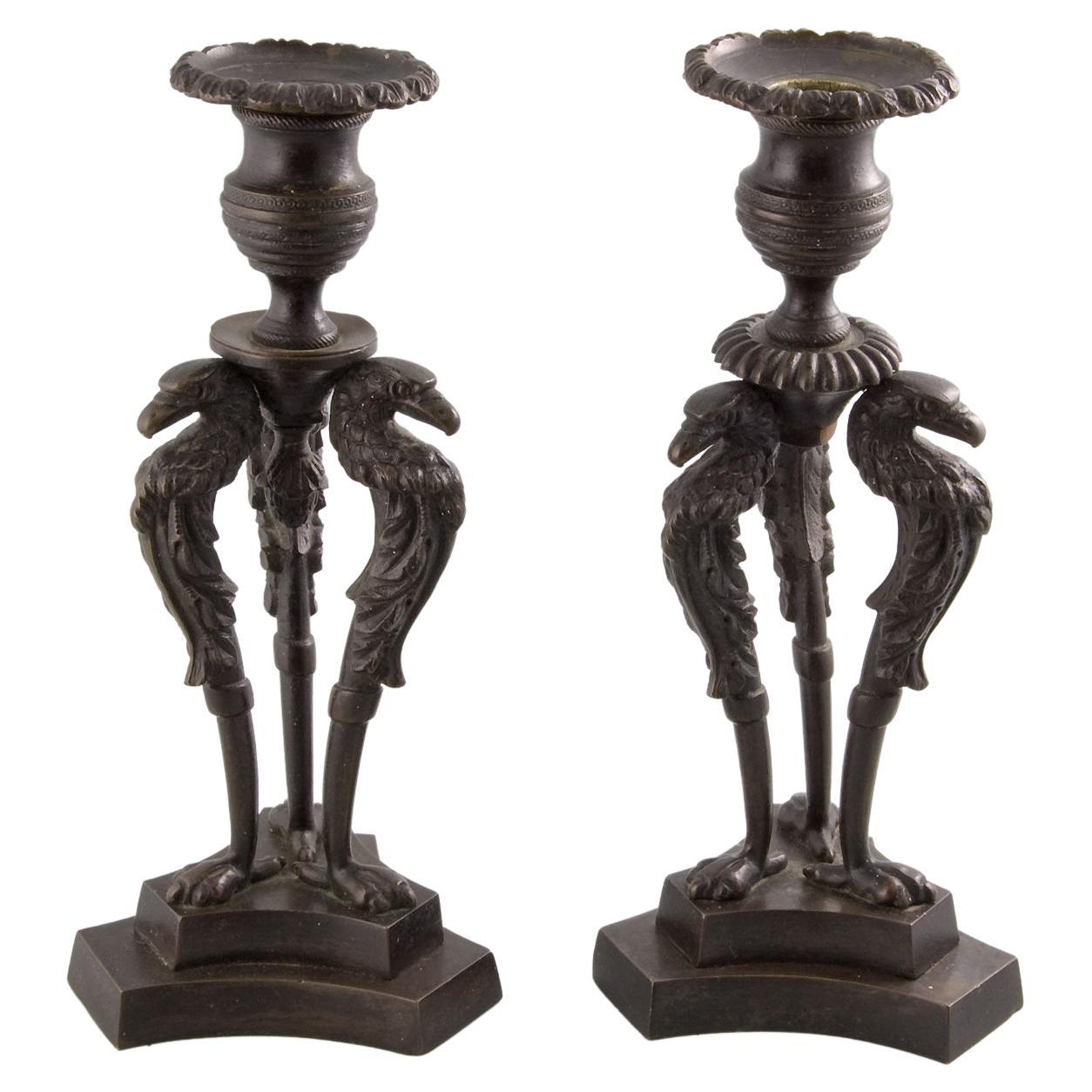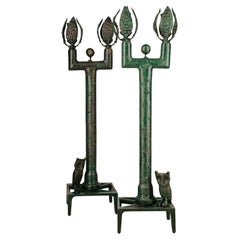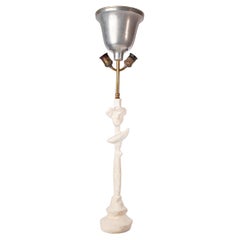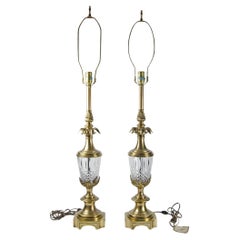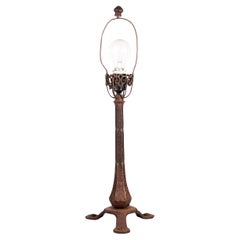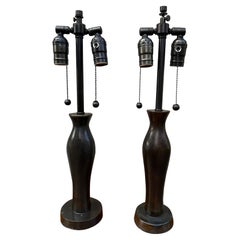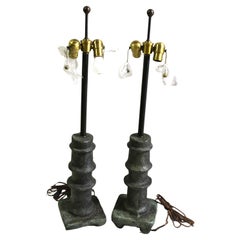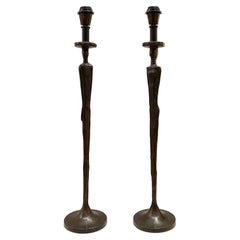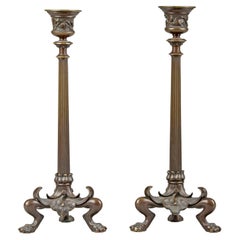Items Similar to Rockefeller Collection's Bronze Lamp Bases After Giacometti's 'Tête de Femme'
Want more images or videos?
Request additional images or videos from the seller
1 of 9
Rockefeller Collection's Bronze Lamp Bases After Giacometti's 'Tête de Femme'
$37,000
£28,102.41
€32,322.91
CA$51,696.25
A$57,647.17
CHF 30,077.84
MX$707,352.52
NOK 382,842.94
SEK 362,735.37
DKK 241,237.85
Shipping
Retrieving quote...The 1stDibs Promise:
Authenticity Guarantee,
Money-Back Guarantee,
24-Hour Cancellation
About the Item
Pair of Expressionist patinated bronze table lamp bases after Giacometti's 'Tête de Femme' (Head of a Woman) cast by Excalibur Bronze Foundry from the Rockefeller Collection
By: Excalibur Bronze Foundry, Diego Giacometti (in the style of)
Material: bronze, metal, copper
Technique: cast, patinated, metalwork, molded
Dimensions: 6 in x 20 in
Date: late 20th century, circa 1970
Style: Expressionism
Place of origin: United States
This pair of bronze table lamps epitomizes the graceful sculptural style of Diego Giacometti, showcasing his adeptness with proportion and form. Cast by Excalibur Bronze Foundry in bronze with a rich brown patina, the lamps feature Giacometti's iconic female head design emerging just below the socket and lampshade, blurring the line between functional object and figurative sculpture. The modeling is delicate yet substantial, with slender necks supporting the elongated heads while the patina enhances the fluid, sculptural bronze.
Though utilitarian in purpose, the lyrical artistry elevates the lamps to works of art. This set embodies the exceptional craftsmanship and elegant functionality that distinguish creations by the talented Giacometti brothers and their command of the Expressionist style.
With origins from the famed Nelson Rockefeller Collection, this edition was cast in the 70s by Excalibur Bronze, USA, as indicated by the impressed manufacturer's stamps. In 1977, Nelson Rockefeller established the Nelson Rockefeller Collection Inc. to reproduce small editions of original works by Diego and Alberto Giacometti in bronze. After over four decades, these high-quality bronze reproductions from the Rockefeller collection remain highly desirable.
These table lamps are presented without electrical cords, allowing the purchaser the freedom to customize the lamps' installation according to their lighting needs and interior design aesthetic.
- Similar to:Diego Giacometti (Designer)
- Dimensions:Height: 20 in (50.8 cm)Diameter: 6 in (15.24 cm)
- Power Source:Plug-in
- Voltage:110-150v,220-240v
- Lampshade:Not Included
- Style:Expressionist (In the Style Of)
- Materials and Techniques:
- Place of Origin:
- Period:
- Date of Manufacture:1970s
- Condition:Wear consistent with age and use. These table lamps are presented without electrical cord, allowing the purchaser the freedom to customize the lamps' installation according to their lighting needs and interior design aesthetic.
- Seller Location:North Miami, FL
- Reference Number:1stDibs: LU8678238068812
About the Seller
5.0
Gold Seller
Premium sellers maintaining a 4.3+ rating and 24-hour response times
Established in 2011
1stDibs seller since 2023
46 sales on 1stDibs
Typical response time: 1 hour
- ShippingRetrieving quote...Shipping from: Buenos Aires, Argentina
- Return Policy
Authenticity Guarantee
In the unlikely event there’s an issue with an item’s authenticity, contact us within 1 year for a full refund. DetailsMoney-Back Guarantee
If your item is not as described, is damaged in transit, or does not arrive, contact us within 7 days for a full refund. Details24-Hour Cancellation
You have a 24-hour grace period in which to reconsider your purchase, with no questions asked.Vetted Professional Sellers
Our world-class sellers must adhere to strict standards for service and quality, maintaining the integrity of our listings.Price-Match Guarantee
If you find that a seller listed the same item for a lower price elsewhere, we’ll match it.Trusted Global Delivery
Our best-in-class carrier network provides specialized shipping options worldwide, including custom delivery.More From This Seller
View AllLate 20th C. Expressionist Giacometti-Like Pair of French Bronze Candle Holders
By Diego Giacometti
Located in North Miami, FL
Late 20th century Expressionist Giacometti-like pair of french bronze candle holders
By: Diego Giacometti (in the style of)
Material: bro...
Category
Late 20th Century French Expressionist Candlesticks
Materials
Bronze, Metal, Copper
Expressionist Sculptural Plaster Lamp 'Tête de Femme' by A. Giacometti, France
By Alberto and Diego Giacometti, Alberto Giacometti
Located in North Miami, FL
1940s Expressionist plaster and brass sculptural lamp 'Tête de Femme' designed by Alberto Giacometti, France
By: Alberto Giacometti
Material: plaster, brass, metal, copper, zinc
Tec...
Category
Vintage 1940s French Expressionist Table Lamps
Materials
Metal, Brass, Copper, Zinc
Pair of Mid-Century Modern Brass and Glass Table Lamps by Stiffel, United States
By Stiffel
Located in North Miami, FL
Pair of Mid-Century Modern golden brass and glass table lamps by Stiffel, United States
By: Stiffel
Material: brass, copper, zinc, metal, glass, crystal, cord
Technique: cast, molde...
Category
Vintage 1960s American Mid-Century Modern Table Lamps
Materials
Crystal, Metal, Brass, Copper, Zinc
Late 19th Century Arts & Crafts Metal Cast Iron Table Lamp, United Kingdom
Located in North Miami, FL
Late 19th century century Arts & Crafts three-legged metal cast iron table lamp, United Kingdom
By: unknown
Material: iron, metal, cord
Technique: cast, molded, metalwork, forged, h...
Category
Antique Late 19th Century British Arts and Crafts Table Lamps
Materials
Metal, Iron, Wrought Iron
Pair of 20th C. French Neoclassical 9-Light Bronze Candelabra with Marble Base
Located in North Miami, FL
Set of early 20th century french Neoclassical 9-light silvered bronze candelabra with marble base
By: Unknown
Material: marble, metal, silver, stone, bronze, copper
Technique: cast,...
Category
Early 20th Century French Neoclassical Candelabras
Materials
Stone, Marble, Metal, Silver, Bronze, Copper
Pair of Early 20th Century Plated 3-Arms Candelabras from France by Christofle
By Christofle
Located in North Miami, FL
Pair of early 20th century plated 3-arms candelabras from France by the company Christofle
By: Christofle
Material: silver, silver plate, metal
Technique: silvered, plated, metalwor...
Category
Early 20th Century French Art Nouveau Candelabras
Materials
Metal, Silver, Silver Plate
You May Also Like
Bronze Lamps after Alberto Giacometti "Grecque" Table Lamps
Located in East Hampton, NY
Beautiful solid bronze lamps after Alberto Giacometti "Grecque".... one is 1/2" taller at the body but has been evened at the top with shade.... newly rewired with silk covered cordi...
Category
Mid-20th Century Table Lamps
Materials
Bronze
Mid Century Modern Bronze Lamps, s after D. Giacometti
By Alberto and Diego Giacometti
Located in Los Angeles, CA
A popular Design of Lamp cast in lost wax bronze with a brown/green patina finish . With the typical look and texture by Giacometti . Has a double Delux socket assembly with pull cha...
Category
2010s American Art Nouveau Table Lamps
Materials
Bronze
2 Sculptural Art Deco Lamp "Tribute to Alberto Giacometti", Porta Romana, 2000s
By Porta Romana, Jean-Michel Frank, Alberto Giacometti
Located in Lille, FR
Evocative of Alberto Giacometti’s figurative sculptures, the Man and Woman pieces come as an odd pair. Constructed in cast composite (jesmonite) and handpainted, the texture of these...
Category
Early 2000s British Art Deco Table Lamps
Materials
Resin, Paint
Mid 19th Century Empire Style Bronze Patinated Candleholders
By Ferdinand Barbedienne
Located in Casteren, Noord-Brabant
A pair of fine French Empire style brown patinated bronze candlesticks from the Napoleon III period. A fluted column beautifully decorated with ivy, rises on a tripod with claw-shape...
Category
Antique Mid-19th Century French Empire Candlesticks
Materials
Bronze
Pair of Bronze Table Lamps
Located in New York, NY
Pair of circa 1920's French patinated bronze table lamps shaped as 3 intertwined stylised dolphins.
Measurements:
Height of body: 22"
height to shade rest: 31"
Diameter: 8"
Category
Vintage 1920s French Table Lamps
Materials
Bronze
$5,800 / set
English Regency candlesticks in patinated bronze
Located in London, GB
A very fine and original pair of English late regency or George IV candlesticks in patinated bronze. Set on a stepped triform base the candleholder is held by three monopedia Eagles....
Category
Antique 1820s English Candlesticks
Materials
Bronze
More Ways To Browse
Giacometti Table
Alberto Giacometti Tables
Woman Bronze Table
Giacometti Diego
Bronze Giacometti Table
Tete De Femme Lamp
Nelson Rockefeller Collection
Giacometti Lamp Tete
Giacometti Tete De Femme Lamp
Giacometti Tete De Femme
Hand Painted Roses Lamp Antique
Lady Figure Table
Lucite Column Lamp
Male Female Lamps
Pair Of Celadon Lamps
Sevres Porcelain Lamp 19th Century
Antique Bronze Lamps Urns
Antique Copper Lamp Shade

